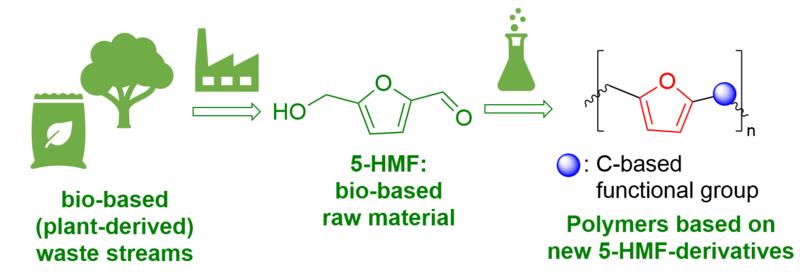Summary
- Profile Type
- Technology offer
- POD Reference
- TODE20231219010
- Term of Validity
- 9 January 2024 - 8 January 2026
- Company's Country
- Germany
- Type of partnership
- Research and development cooperation agreement
- Investment agreement
- Targeted Countries
- All countries
Contact the EEN partner nearest to you for more information.
Find my local partner
General information
- Short Summary
- A German university has developed a process that can replace petroleum-based polymers. These are furan-containing biopolymers whose starting material can be produced from plant carbohydrates. The university offers license agreement as well as a technological cooperation.
- Full Description
-
Given the urgency of avoiding the environmental problems associated with conventional polymers, environmentally friendly manufacturing processes are enjoying increasing popularity. The last few years have seen a number of attempts to replace the oil-based polymers that have so far been used in industry and daily life with alternatives based on renewable raw materials. One promising alternative is biopolymers that contain furan, since an important starting material for these polymers, 5-hydroxymethylfurfural (5-HMF), can be manufactured from vegetable carbohydrates.
This invention from a German university involves polymers containing furan, monomer precursors for manufacturing such polymers, and manufacturing procedures for both the polymers and the precursors. The 5-HMF derivatives have such substituents as hydroxymethyl, aldehyde, and cyano and can also be further derivatized. These compounds also serve as monomers for such substances as biodegradable polyester, polyamides, polyamines, and polyurethanes.
5-HMF can be made from D-fructose, which in turn can be made from biomasses such as the cheap, readily available vegetable waste streams. Potential areas of application for the new 5-HMF-based polymers include composite materials, foams, organic adhesives, textile materials, and coating materials, especially paints and lacquers. Since precursors upon which these polymers are structurally based have so far not been described in the literature, there are many opportunities for IP associated with patent protection for substance for the relevant target products.
This invention is aimed at companies in the following sectors: chemicals, coatings, adhesives, plastics and the environment. The university is offering a license agreement. Technological cooperation to further develop the process is also conceivable. - Advantages and Innovations
-
The main advantages of this invention are:
- simple synthesis
- sustainable chemistry
- environmentally friendly products
- “tunable” properties - Stage of Development
- Lab tested
- Sustainable Development Goals
- Goal 9: Industry, Innovation and Infrastructure
- IPR status
- IPR applied but not yet granted
- IPR notes
- A patent application has been submitted to the German Patent and Trade Mark Office. A PCT application can be submitted within the priority year.
Partner Sought
- Expected Role of a Partner
- This invention is aimed at companies in the following sectors: chemicals, coatings, adhesives, plastics and the environment. The university is offering a license agreement. Technological cooperation to further develop the process is also conceivable.
- Type and Size of Partner
- SME <=10
- Big company
- SME 11-49
- Other
- SME 50 - 249
- Type of partnership
- Research and development cooperation agreement
- Investment agreement
Dissemination
- Technology keywords
- 02007020 - Biobased materials
- 02007014 - Plastics, Polymers
- 02007001 - Adhesives
- Market keywords
- 08001007 - Coatings and adhesives manufactures
- 08001001 - Plastic fabricators
- 08001006 - Processes for working with plastics
- 08001018 - Polymer (plastics) materials
- 08001005 - Other fabricated plastics
- Targeted countries
- All countries
